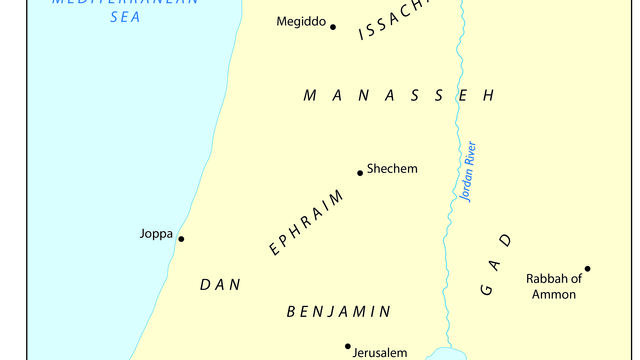Entering the Land of Israel and Rule by Judges
How did the ancient Israelites enter the land of Israel according to the Bible?

What does the biblical account say about the Israelite conquest of Canaan?
Joshua inherits the leadership of the people from Moses and brings them into the land of Canaan. The book that bears his name is a story of military conquests, most famously the battle of Jericho. Israel defeats almost all of the Canaanite population and takes possession of the land that God promised them. The themes of obedience to God and avoidance of Canaanite religious practices are central to the book of Joshua.
The Israelites settle in the land, in the areas designated for each tribe. This tribal organization is reflected in the early period of settlement, the time of the “judges,” or tribal chieftains. Repeatedly, when Israel sins, a neighboring nation attacks one or more Israelite tribes until the people turn back to God. God then raises up a chieftain to defeat the enemy and ensure safety for the tribes. This repeating pattern emphasizes the overall theme of the book of Judges: the welfare of Israel depends on fidelity to YHWH, Israel’s God. The book celebrates the heroism of these tribal leaders, but also plants the seeds for a new and more cohesive form of organization, the monarchy.
What does archaeology reveal about Israelite origins in Canaan?
Archaeological evidence regarding the Israelite entrance into Canaan is ambiguous and intensely debated among archaeologists. Some of the cities that the Israelites destroyed quickly, according to the book of Joshua, were actually destroyed over a period of decades or were uninhabited at the time. The Israelites may have destroyed some cities, but the biblical tradition of a sweeping military conquest in the course of a few years is at best exaggerated.
The earliest datable reference to the Israelites is an inscription on a stela of the Egyptian pharaoh Merneptah from circa 1208 BCE that refers to them as an ethnic group located in or near the land of Canaan. There is no explicit documentation of the Israelites for the next several centuries, but archaeological evidence reveals that in the twelfth and eleventh centuries BCE, hundreds of small settlements were established in the central hill country and upper Galilee and other areas where Israelites later lived. Although the identity of the inhabitants cannot be determined, they may well have been, or included, early Israelites. Urbanization began in the tenth century, and by the ninth century, when the textual evidence resumes, the Israelites had become two independent kingdoms. The stela of Mesha, king of Moab (ca. 835 BCE), and the stela of an Aramaean king, probably Hazael of Aram-Damascus, found at Tel Dan (late ninth century BCE) both mention kings of Israel and the house of David.

